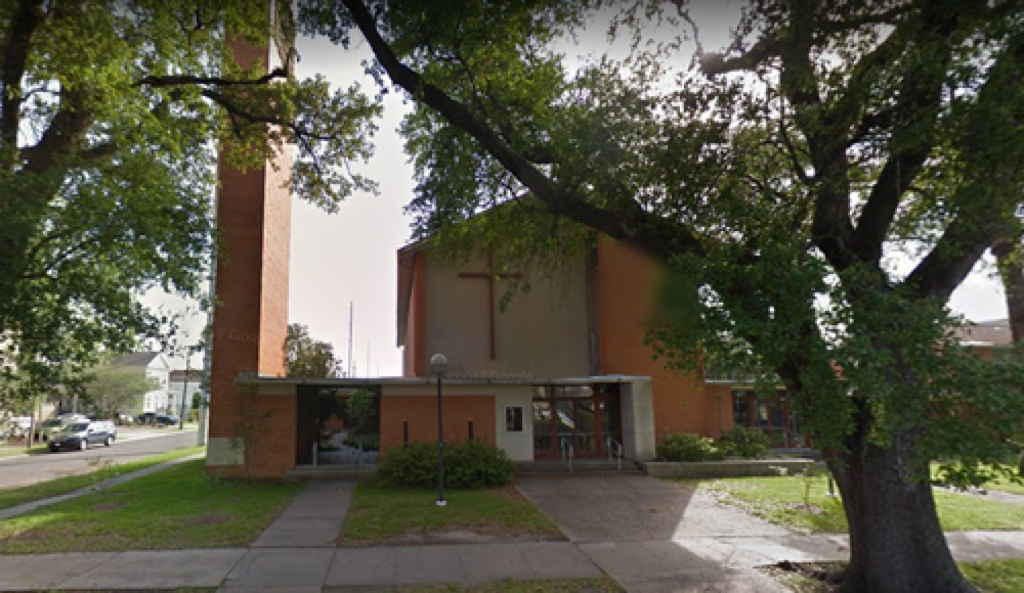Proposed assisted living facility in former Grace Episcopal Church encountering some pushback from neighbors

A proposed assisted living facility housed in an abandoned historic Canal Street church is being criticized by neighbors for it’s imposing mass upon the neighborhood. The city’s Historic District Landmarks Commission recently deferred action on the plans after pushback from nearby residents, causing developers to change up some of the plans.
Developers say the project will preserve the historic Grace Episcopal Church building on 3700 Canal St. while returning life to the abandoned rectory once again. Critics of the project are rallying against the project’s size – which adds mass to the sizable church – and how an assisted living facility would impact traffic, parking and business in the neighborhood.
Charles Ward, with Rozas-Ward Architects, presented updated project plans to members of the Mid-City Neighborhood Organization Monday evening. Developers are proposing a three-story assisted living facility with 12 memory-care units and 68 independent living quarters, totaling about 80 residences. The lot is already zoned commercial and the third floor will stay below the limited 40 feet, Ward said.
The property is bordered by South Telemachus Street, South Cortez Street and Cleveland Avenue.
The project technically requires 42 parking spaces but, due to the church’s grandfather status, 48 parking spots have been waived.
“In order to encourage the reuse of existing structures, this Ordinance allows for the grandfathered deficiency of vehicle parking spaces of the immediate previous legal use,” according to article 22.2 of the city’s Comprehensive Zoning Ordinance.
Developers will instead provide 23 parking spots in a separate lot. That lot provides 23 more spots than is actually required due to the grandfathered status, Ward said. Neighbors disagreed.
“You have a right to do this under the zoning law, but that doesn’t mean it’s the right thing to do for this neighborhood,” one woman said.
The facility will employ about 60 people, with 25 staffers onsite during peak daytime hours. David Schonberg, Chief Executive Officer of Schonberg Care, said about half a dozen residents will drive and the facility will offer onsite therapy, beauty and food services. Schonberg plans to run the assisted living and memory care site once it’s complete.
Residents will have visitors, which neighbors say will only add to the parking troubles.
“The last thing you want is a senior community that people don’t come visit, that people don’t pay attention to,” Schonberg said.

Plans for 3700 Canal St. include a three-story structure for assisted and independent living, though the third floor will remain below the church’s current rectory (Image submitted to the City of New Orleans’ One Stop App).
Schonberg runs several other assisted living and memory care facilities in Louisiana and Mississippi; the closest is Vista Shores on St. Bernard Avenue. He said the location fits with an assisted living facility’s demographics, and he’s interested in putting an abandoned property into use.
Mary Gubala, who lives on South Genois Street, said the proposed new construction does not fit within the neighborhood’s historic architecture. And addition to the church, even if it’s below 40 feet, would dwarf the smaller houses surrounding 3700 Canal St., she added.
Nearby neighbor Michelle Schlafly, joined by several others, voiced concerns about the project’s size, especially in a residential neighborhood. Project approval was originally deferred from a January Historic District Landmarks Commission Architectural Review Committee meeting, due to a number of neighborhood pushback. Original plans allowed for the facility’s third story to rise above 40 feet; new plans show the third story stays well below the initial height.
The project goes back to the HDLC’s Architectural Review Committee on Feb. 20 and, if approved, will move to the regular HDLC agenda.
“If they give us a homework list then we’ll do our homework and go back 30 days later,” Ward said.
Grace Episcopal Church shuttered in 2011 after years of little attendance and a lack of a full-time rector. It moved into its current home in 1954.http://midcitymessenger.com/2018/02/06/proposed-assisted-living-facility-in-former-grace-episcopal-church-encountering-some-pushback-from-neighbors/

